A real-deal dan dan noodle recipe that stays true to the authentic Sichuan flavor. This post covers all the key ingredients and includes a super rich and balanced sauce to recreate the classic dish that tastes like China.
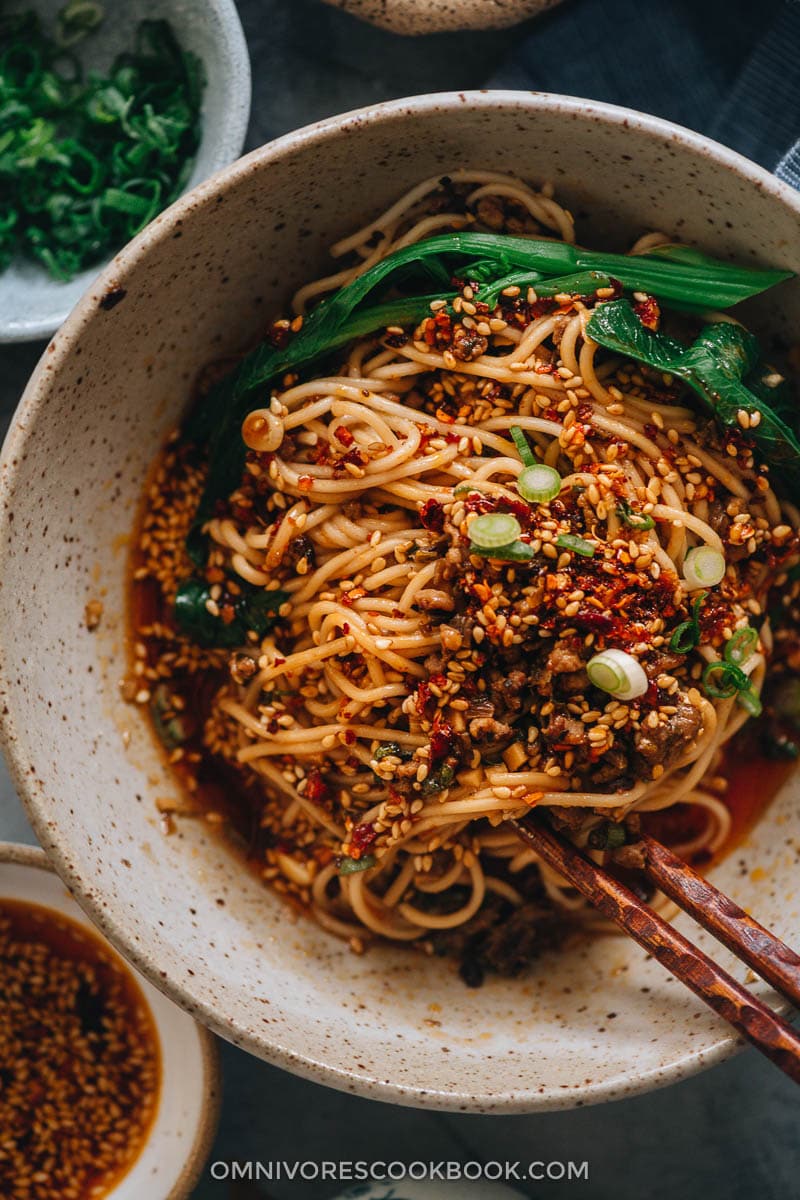
Dan dan Noodles is such a classic dish that is really worth the effort to master. I’ve been improving the recipe since I first published it back in 2014, and this is the third version.
You can head straight to the recipe if you already know the dish. If you are new to Chinese cooking, I recommend browsing the post first so you can learn about the ingredients and pick up a few helpful cooking tips that support the Authentic Chinese noodle recipes collection.
What are Dan Dan Noodles?
Dan Dan Noodles (担担面, dan dan mian) are one of the most famous of Sichuan street foods. The freshly boiled thin noodles are served in a savory, spicy sauce topped with crispy pork and peanut flakes. Simply stir everything together with a pair of chopsticks to coat the noodles with a bit of everything and slurp! The numbing, smoky, spicy sauce will shock your taste buds, leaving you craving for more.
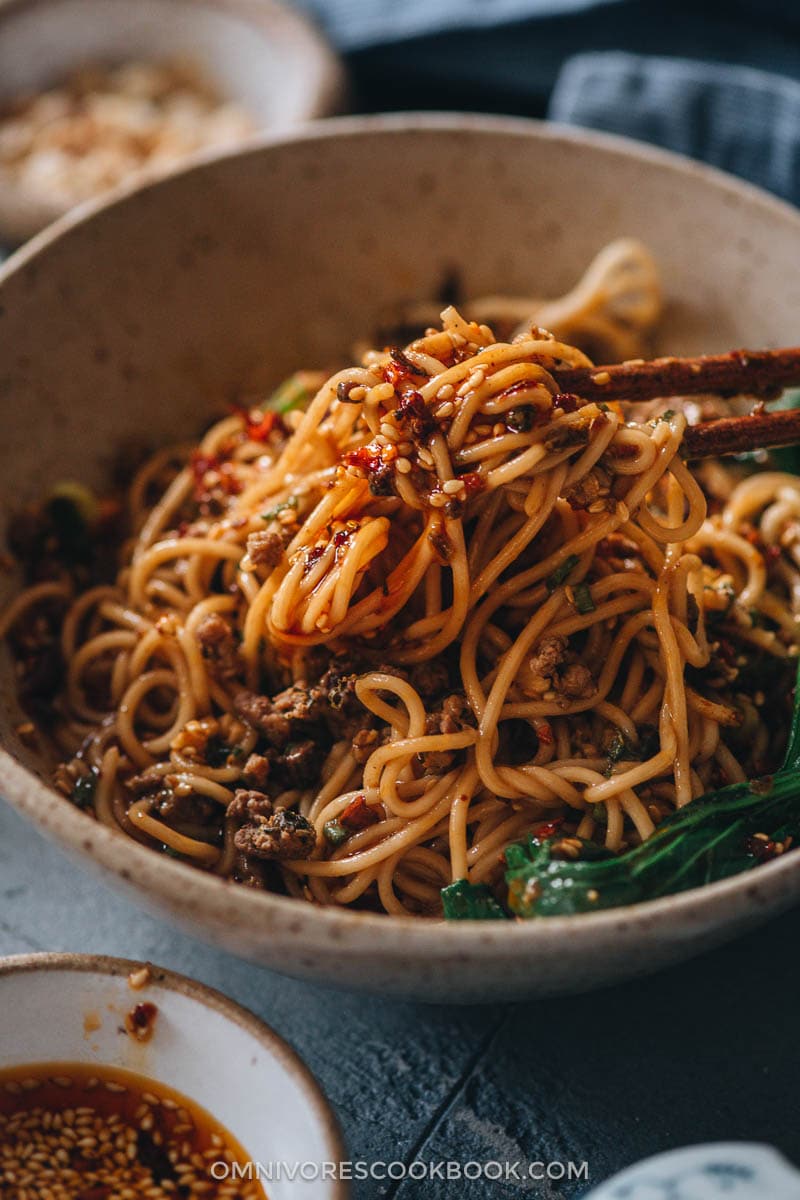
When you go into different restaurants, you’ll find each chef has their own interpretation on dan dan noodles.
In Sichuan restaurants in China, the dan dan noodle dish is more of a snack than a main and is usually served in a small bowl. The noodles are mostly immersed in a thick red broth made with chili oil, with a small amount of pork on top. The dish can sometimes be more soupy and very spicy, but it depends on the chef.
After the dish was introduced in the US, it was transformed and now looks more like a pasta dish — boiled noodles with a meat sauce on top. Sometimes the sauce is more sweet and sour than spicy, almost like a General Tso stir fry (e.g. the Dan dan noodles at Pei Wei). Sometimes the chef will mix Chinese sesame paste into the chili oil to make the sauce creamier and mellow out the spiciness.
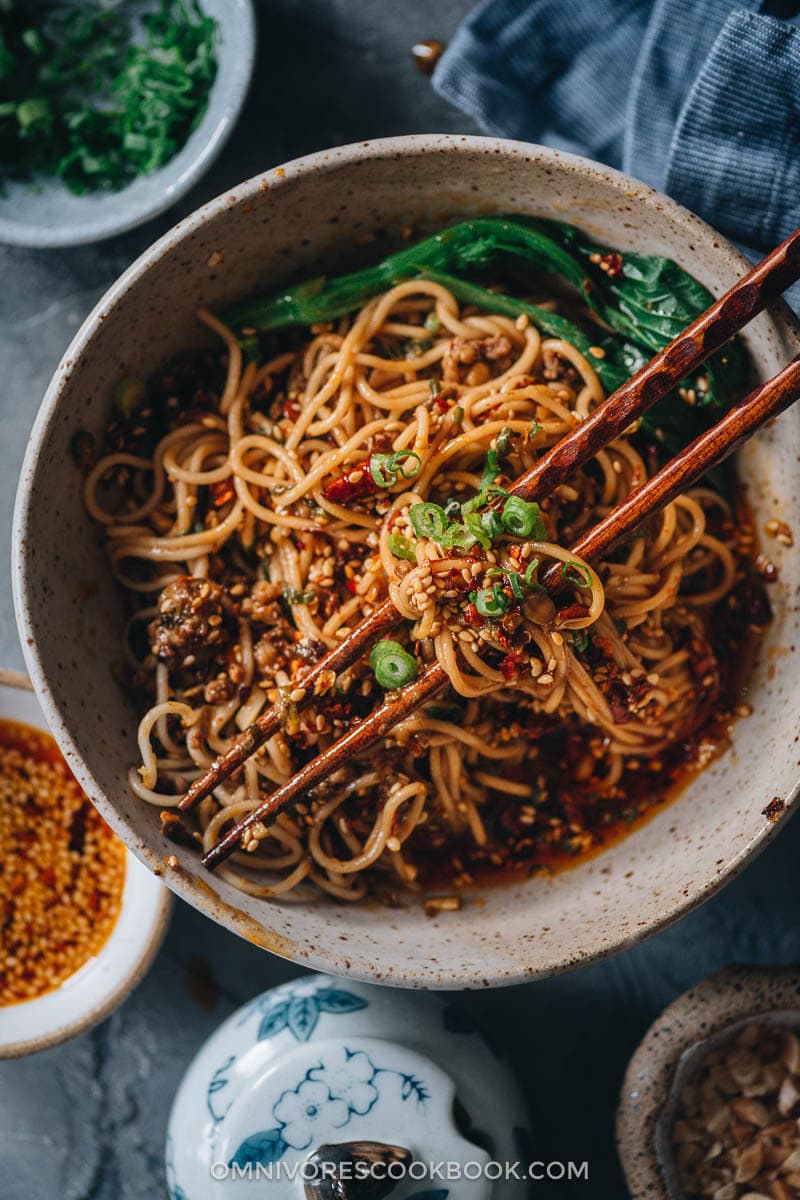
My own interpretation of dan dan noodles
When I make dan dan noodles at home, I use an approach that is 80% true to the original version from Sichuan. You get the ultra-umami, spicy and numbing-ness coming from the fried pork, pickled mustard greens, homemade chili oil, and Sichuan peppercorns. But I also mix in some sesame paste to make the sauce creamier and more appealing to anyone who prefers milder food.
Key ingredients
Sui Mi Ya Cai – or preserved mustard green
Sui Mi Ya Cai (碎米芽菜) is a must-have ingredient if you want to call a dish dan dan noodles in China. It is a type of cardamine bean sprout that is native to Sichuan. It is dried, flavored with sugar and spices, and fermented. The end result is a dark brown pickle that has a crunchy texture and a one-of-a-kind taste — a bit sweet, salty, and savory, with an earthy umami.
It can be tricky to find Sui Mi Ya Cai, since it’s a specialty ingredient, even in China. You can usually find it in the un-refrigerated section of the Asian supermarket with the pickles. If you do not live near an Asian market you can also purchase it on Amazon.
NOTE: It’s totally possible to create a delicious bowl of dan dan noodles without this ingredient.
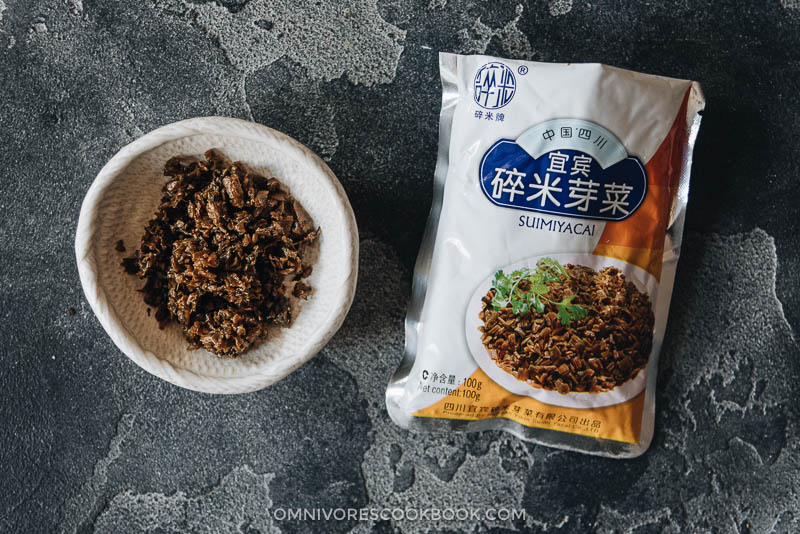
Homemade chili oil
Chili oil is a staple in every family household in Sichuan and the homemade version is a must. It is the main ingredient in dan dan noodles and I highly recommend you make your own. Making chili oil might look daunting at first, but trust me, it only takes 5 minutes. Check out this post to learn how.
NOTE: to anyone who prefers not to eat spicy food — you will still benefit from the homemade chili oil. When you’re making the noodle sauce, you can add a small amount of chili oil to infuse aroma and smokiness; your dish won’t end up very spicy.
Chinese sesame paste
Chinese sesame paste (芝麻酱, zhi ma jiang) is a thick paste made from toasted sesame seeds. Although a lot of original Sichuan dan dan noodle recipes do not contain this ingredient, I prefer to use it to make the sauce creamier. It also balances the spiciness to round out the flavor. It adds great umami too, so your sauce will still taste great if you don’t want to add too much chili oil.
You can find Chinese sesame paste in most Asian grocery stores, or purchase it online. I prefer the sesame paste made with 100% sesame seeds, which has a better taste. You can also find cheaper sesame pastes made from a blend of sesame and peanuts.
NOTE: Chinese sesame paste tastes VERY different from tahini. Do not use tahini as an alternative. If you don’t want to purchase Chinese sesame paste, you can also use natural peanut butter with a few teaspoons of sesame oil mixed in.
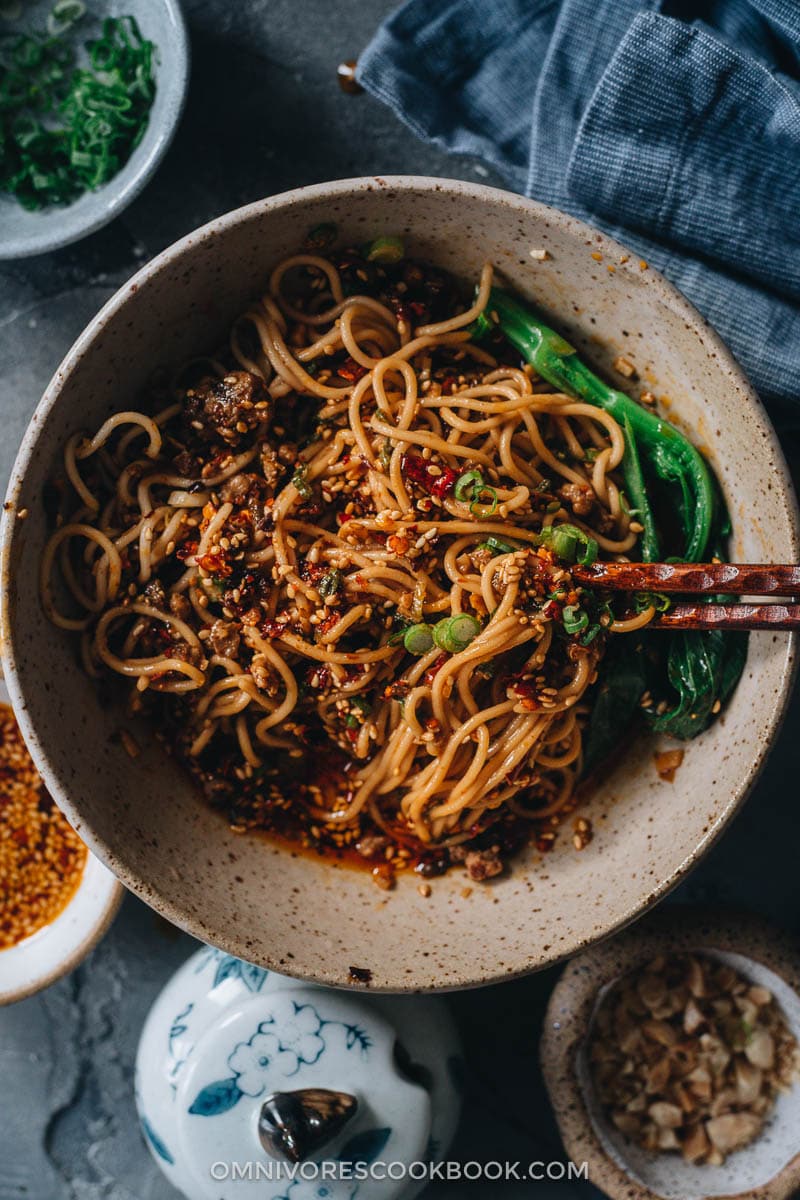
Cooking notes
What type of noodles to use
Dan dan noodles usually use the thin type of wheat noodles. Although it’s usually just a tad thicker than somen noodles. If you’re lucky, you might be able to find the semi-fresh Dan Dan noodles in the refrigerated section in an Asian market. Or you can use any type of dried noodle that is made with wheat and on the thin side.

How to mix the sauce properly
If this is your first time cooking with Chinese sesame paste, you will usually find it is separated into oil on top and thick paste underneath. To make it easy to use, stir the sesame paste thoroughly in the jar to incorporate the oil with the paste. Without this step, you will find the sesame paste very thin on the top of your jar and very dry on the bottom.
Sesame paste has a tendency to thicken when you stir in the liquid. The best way to mix the sauce is to add the sesame paste first, then mix in the liquid ingredients little by little. Whisk the mixture with a pair of chopsticks (or a spoon) until the solid paste is fully blended with the liquid. Then add more liquid and repeat, so everything will dissolve evenly.
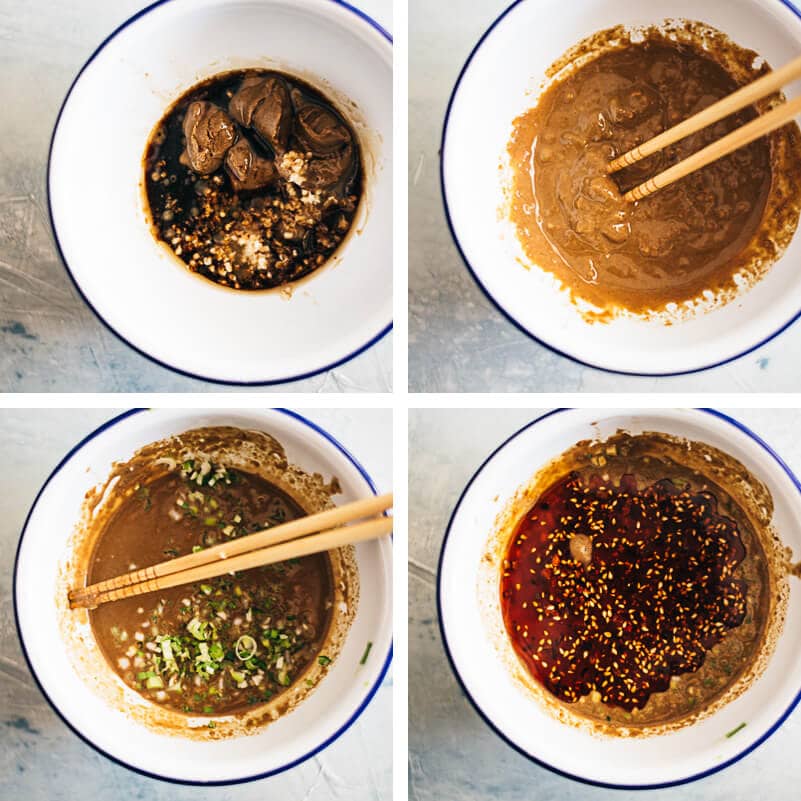
How to fry the pork properly
To properly prepare the pork for dan dan Noodles, you’ll need to “overcook” the pork.
Use medium-high heat to cook brown surface first, then turn to medium heat to let it roast until the liquid in the meat is fully released and evaporated.
In the end you will have dark-brown colored pork without adding any soy sauce. The pork bits will be a bit chewy and have an almost-crispy texture when hot.
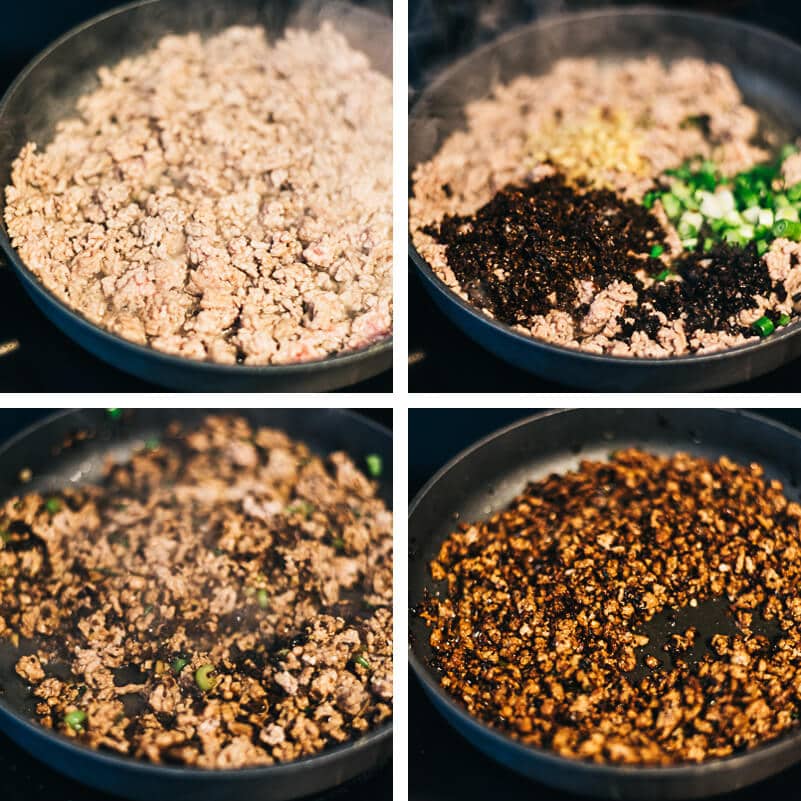
The best workflow
The ingredient list for dan dan noodles might look overwhelming,. The best approach is to get organized and cook one component at a time.
The best workflow is:
- Chop and prep all the vegetables and aromatics
- Mix the sauce (and make chili oil if needed) – this can be prepared ahead
- Cook the pork – Can be prepared ahead
- Boil the noodles
- Use the noodle-boiling water to quickly blanch the vegetables
- Serve everything family-style, so everyone can assemble their noodles the way they like
If you’re preparing this dish for a party, I highly recommend you prepare the sauce and the pork ahead of time. They will stay good in the fridge for a couple of days. Simply boil the noodles and heat up the pork in the microwave right before serving.
To assemble dan dan noodles like a local
To assemble dan dan noodles like a Chinese street vendor:
- Pour some sauce in a small bowl and chili oil according to your taste
- Add the noodles
- Top with minced pork, green veggies, crushed peanuts, and green onions
- Mix and enjoy!
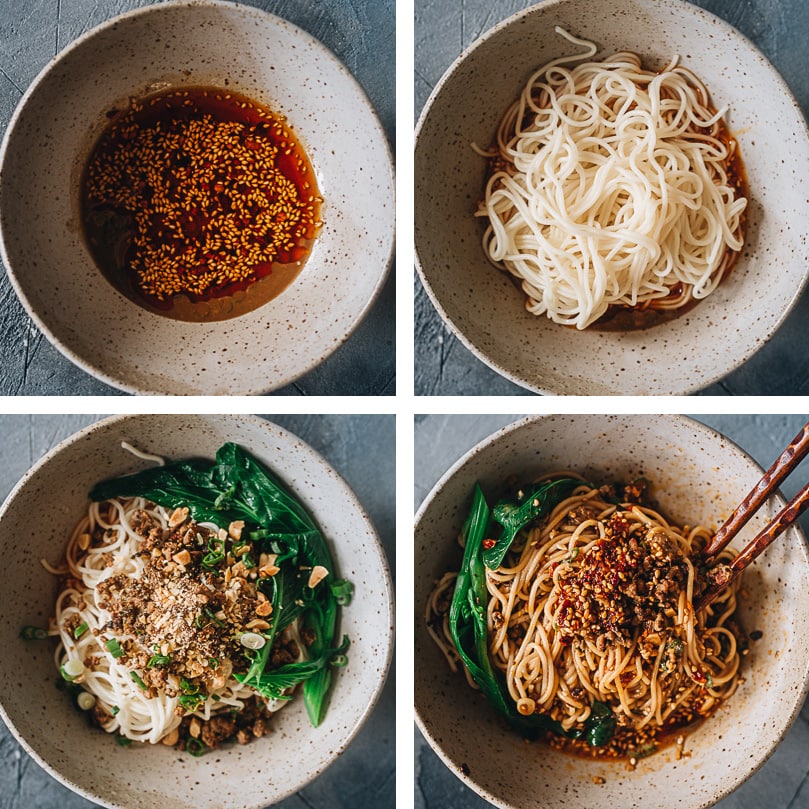
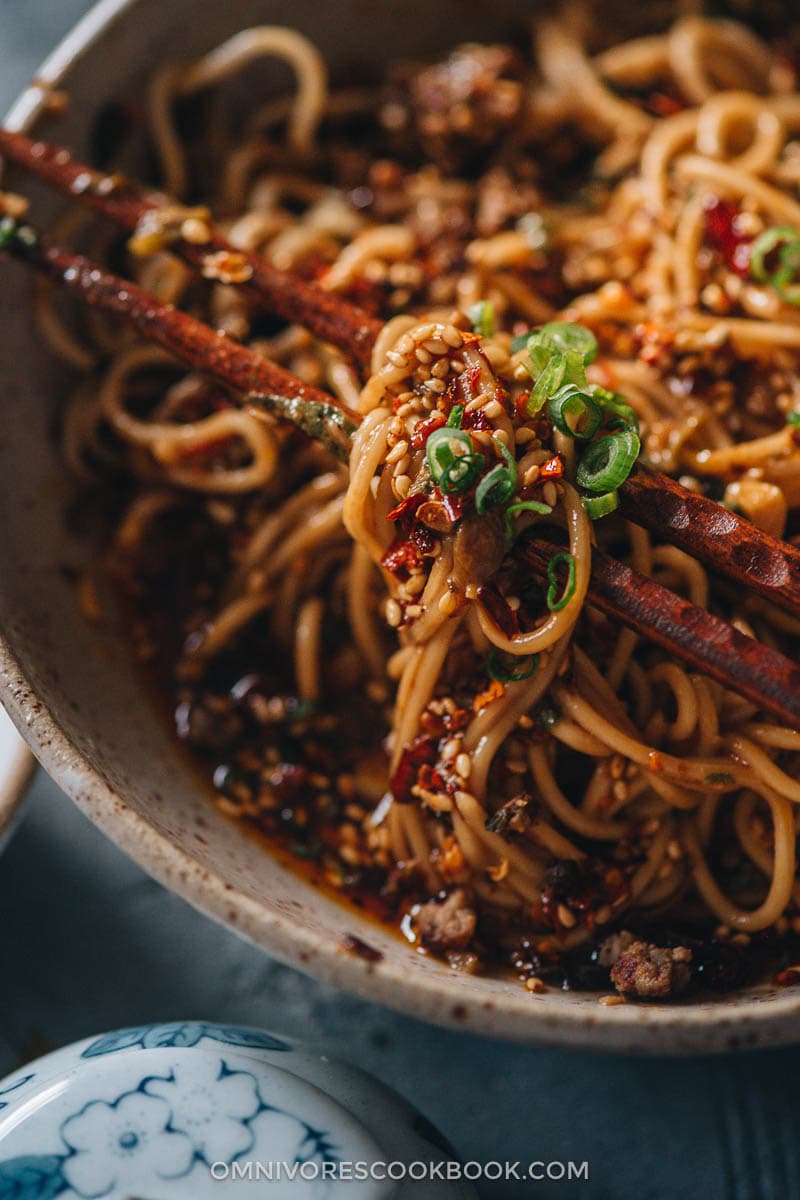
More Sichuan food recipes
- Mapo Tofu
- Sichuan Eggplant Stir Fry
- Dry Fried Green Beans
- Sichuan Mala Chicken
- Sichuan Spicy Wonton in Red Oil
If you give this recipe a try, let us know! Leave a comment, rate it (once you’ve tried it), take a picture and tag it @omnivorescookbook on Instagram! I’d love to see what you come up with.
Chinese Cooking Made Easy
Are you new to this website? This free email series is a great place to start. I’ll walk you through a few of my most popular recipes and show you how and why they work. You’ll quickly start to cook better Chinese food in your own kitchen.
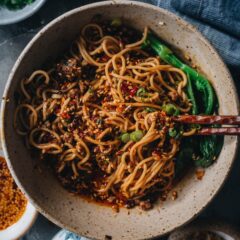
Dan Dan Noodles (担担面)
Ingredients
Noodle sauce
- 1/3 cup Chinese sesame paste (or unsweetened natural peanut butter)
- 1/3 cup light soy sauce (or soy sauce)
- 1/4 cup Chinkiang vinegar
- 4 cloves garlic , finely minced
- 2 green onion , finely minced
- 2 tablespoons honey (or agave syrup)
- 1/2 to 1 teaspoon Sichuan peppercorns , toasted and grounded (*footnote 2)
Pork topping
- 1 tablespoon peanut oil (or vegetable oil)
- 1 lb ground pork
- 1 tablespoon minced ginger
- 2 green onions , chopped
- 1 1/2 tablespoons fermented black beans , rinsed and chopped
- 1/2 cup Sui Mi Ya Cai (Sichuan preserved mustard greens)
- 2 tablespoons Shaoxing wine (or dry sherry)
- 1/2 teaspoon sugar
To assemble
- 1/3 cup roasted peanuts , crushed
- 14 oz Dan Dan noodles (or thin wheat noodles)
- 1 small batch leafy green vegetables , roughly chopped (spinach, choy sum, baby bok choy etc.)
- Homemade chili oil , to taste (*footnote 1)
Instructions
Prepare sauce
- Whisk the sesame paste and light soy sauce together in a bowl until fully incorporated. Add the Chinkiang vinegar. Continue stirring until mixed. Then mix in the garlic, green onion, honey, and Sichuan peppercorns.
Prepare the pork topping
- Heat the oil in a large nonstick skillet over medium-high heat until hot. Add the pork. Cook and stir until the surface is lightly browned.
- Turn to medium heat. Add the ginger, green onion, fermented black beans, Sui Mi Ya Cai, cooking wine, and sugar. Cook and chop the pork into small pieces, until all the liquid has evaporated and the pork turns a dark brown color. Transfer to a bowl and set aside.
Prepare the noodles
- Cook the noodles according to instructions.
- Briefly blanch the leafy green vegetables, drain, and set aside.
To assemble the noodle bowls
- For each noodle bowl, add 1/4 cup of noodle sauce. Add the chili oil according to your taste. Add some noodles, then top with a few spoonfuls of the cooked pork and green veggies. Garnish with peanut crumbles and chopped green onion. Sprinkle with a pinch of toasted ground Sichuan peppercorn, if you like the numbing taste.
- Serve hot or cold.
Notes
Nutrition

Did you make this recipe?
I’d love to hear how it turned out for you! Please take a moment to leave a 5-star rating ⭐️ and share your thoughts in the comments further down the page. It really helps others discover the recipe too.
The recipe was originally published by Feb. 26, 2015 and updated on Apr. 27, 2017.

MJo
Hi Maggie, This was delicious!!! We used to live in Hong Kong and absolutely loved the dan dan mien at Crystal Jade. We’ve now moved back home to the states and have not found anything like it. Every time we find “dan dan noodles” on a menu, we try it and it is just never the same. You are right, chefs all have their different versions, but yours comes pretty close to our favorite at Crystal Jade. We made it tonight and were all delighted by how it turned out. Thank you so much!! This is a keeper!!
Nada
Hi! Can I make this with beef? If so, what modifications would I need to make?
Thanks!
Maggie
Hi Nada, yes you can make it with beef and no modifications are needed. I’ve done it in the past and it always turns out great.
Happy cooking and let me know how the dish turns out! 🙂
Nada
Any tips on how to make the beef juicy and not dry?
Thanks!
Maggie
The best way is to use a heavy and large pan and heat the pan to really hot before adding the beef. Also, do not move the beef for 30 seconds to a minute once you add it, so the pan will heat up again. Try to break apart the ground meat without stirring too much. The higher heat the pan gets, the quicker the beef browns without losing all the juice and get steamed. I also found adding some cornstarch and cooking wine to the ground meat (1 tablespoon each for 1 lbs beef) will help to generate a tender result.
Jen
I used Lao Gan Ma chili oil and the whole thing tasted divine! My husband and I ate way too much of it just now. Thank you for sharing!
Maggie
Hi Jen, I’m so happy to hear you tried the recipe and enjoyed the dish! OMG adding Lao Gan Ma chili oil will definitely make the dish addictive! I won’t able stop eating if I do that 😛 Thanks for taking time to leave a comment 🙂
David Perlmutter
LOVED these noodles!!!. Used peanut butter instead of sesame paste and omitted the mustard greens. Still delicious!
Elisa
Ayyye. I desperately want to make this but I have access to so few of the ingredients… frustration!
Just found your blog by the way. So generous, interesting, rich and thorough! The mooncakes… I’m hooked, thank you for this beautiful material you’re gifting us with.
Maggie
Hi Elisa, thanks so much for the kind words. Yes the Dan Dan noodles require a LOT of special ingredients. If you do not have an Asian market nearby, you can get most of the stuffs on Amazon and super fresh Sichuan peppercorns from The Mala Market. Hope you can manage to source all the ingredients and make the noodles. They are really good 🙂
John
This recipe seems to call for about 4 fluid oz of “stuff” (soy sauce, vinegar, honey, sesame paste) and then 2/3 – 1 CUP of chili oil. From the appearance of this pictures, perhaps this should be 2/3 – 1 TABLESPOON? Or did you really mean “cup”? With 4 times as much chili oil as sesame paste, I’m pretty sure that I couldn’t even taste the sesame flavor.
Maggie
Hi John, yes I did mean cup. The oil always sinks to the bottom of the bowl, so it’s not that obvious in the photo. The authentic Sichuan version uses chili oil as a main ingredient in the sauce. Since you’ll be making the oil fresh, the dish will taste very fragrant. Although it’s totally fine to add less chili oil if the spicy flavor does not appeal to you. In this case, I suggest you mix the sauce without the chili oil first, then you can try to add the oil into single serving bowls to your taste.
Karla
I make your dan dan recipe overtime and love it. It is similar to the other guys (and I love all these recipes out there, not downing anyone) but yours for some reason is just more fitting to my family. Thank you for sharing and allowing all to explore different foods at home!
ania
This recipe sounds amazing
Tracee
My girls is from Hunan. We love spicy in our house!
Jeff
These noodles look incredible! It looks like the kind of dish I would order off a menu in an instant, but I would never dream of making at home. So thank you for the recipe.
Inci @ Bella’s Apron
Love the pictures and love this recipe. This looks so great and I can’t wait to give it a try at home
Robin
Made this twice now and it’s turned out very well. Used frozen Japanese udon noodles which seemed to work well, but the quantity of liquid seemed a little bit high (“fill bowl until almost covering noodles”). I ended up just adding more chili oil though, and it worked out. Maybe the udon noodles don’t absorb as much liquid as others.
Anyway, very delicious – thanks for this recipe.
Maggie
Hi Robin, I’m glad to hear you enjoyed the dish! I never used frozen udon noodles for this one yet, but I think it will work. The thin noodles I used absorb tons of water, so I ended adding more. If it does not work for your noodles, do try adding less soup the next time.
Hope you have a great week ahead 🙂
Marissa
Hey Maggie! 🙂 I’ve been meaning to make this recipe for ages – it looks so good. A couple of questions: Do you store your homemade chili oil in the fridge? I see some Dan Dan Noodle recipes that call for pickled mustard greens – are you familiar with them? Thanks friend!
Maggie
Hi Marissa, happy to see you here! To answer your questions, yes, I do store my chili oil in the fridge. You don’t have to if you make a small batch and use them fast. But storing it in the fridge will prevent it from getting rancid much longer. As for mustard greens, yes, the authentic dish does use it for topping. You can get it in Asian market. It is fermented mustard greens, basically a pickle. The Asian market here is too small and I couldn’t find it at the time, so I skipped it in this recipe.
Happy cooking and let me know how the dish turns out 🙂
Marissa
Thanks, Maggie! I got a bunch of mustard greens in my CSA share yesterday. I think I’ll try pickling them myself. To use them in this recipe, when would a you add them in and about how much? Thanks for your help! So excited to try this!
Maggie
Hi Marissa, you can use this recipe to make the pickle: http://www.chinasichuanfood.com/pickled-mustard-green-recipe/
Once you finished making the noodles, simply chop a tablespoon pickled mustard greens and top them with the minced pork.
Hope your dish turns out great!
Marissa
Thanks so much, Maggie! xo
Emily P.
I made this recipe this morning (with the fresh chili oil) and it was DELICIOUS!! I was worried the chili oil would be harder than it actually was – it’s fairly simple except I wasn’t sure at first what to use for chili flakes. I ended up putting some Tien Tsin peppers in a food processor to ground them up. I also bought frozen noodles from a Chinese grocery nearby. I haven’t had a bowl of noodles like this since I left China- awesome!!
Thank you for the recipe!
Julie
I tried this Dan Dan Noodle recipe today. I used fresh noodles instead of the dried–I found the boiling water and noodles to be very starchy. Should I have rinsed them? and used fresh boiling water with the chili sauce? Also, how do you keep your noodles from sticking together?
Alice
Hi, Maggie! I am a fan of Dan Dan Noodles, but I have been making it with a jarred sauce, mixed with pork. Not exactly authentic! Your version looks much better, and the tip about using the noodle cooking water is genius! Can’t wait to try your recipe!
Maggie
I’m so glad to hear you are interested in trying out this recipe! It takes a bit more time than using jarred sauce, but if you already have some chili oil (I always do, because they stay forever in the fridge), it will be super simply to make these noodles.
Happy cooking and let me know how the dish turns out 🙂
mira
I haven’t tried dan dan noodles, but I feel like I’m missing out! Looks delicious, great flavor, I love the sauce!!!
Kathleen | HapaNom
Oh Maggie, you’re singing to my heart! I love dan dan noodles, and your recipe looks absolutely amazing! I wish I had a big bowl of this right now! I can’t wait to get back home (still traveling in Europe) and make this dish!
Thao @ In Good Flavor
I have never had dan dan noodles, but I can inhale a bowl of it right now. It looks so good!
Karen @ The Tasty Bite
I love dan dan noodles but have never tried making them. What kind of spicy sauce do you recommend? Would sriracha or garlic chili sauce work?
Maggie
Hi Karen, for the the spicy sauce, I used the homemade one and you could check it here (The recipe called “spicy sauce”). I never tried to cook it with Sriracha, but I think the result will be quite different. You could purchase Chinese chili oil, also calls red oil, in China town. But I highly recommend make it at home, because the taste will be much better for freshly made chili oil, and it’s quite easy to cook.